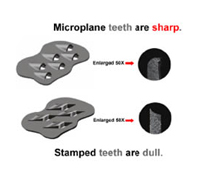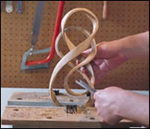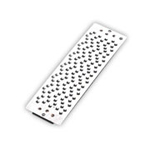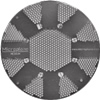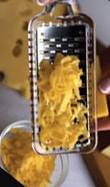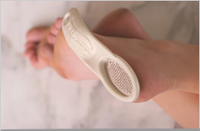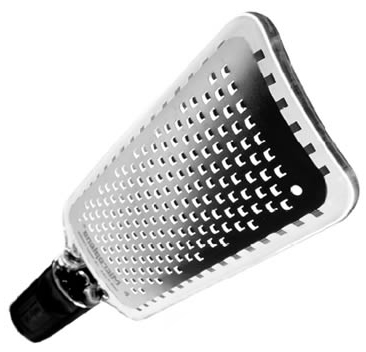
What happens when a business owner with a very fertile imagination and a penchant for woodworking starts tinkering with some dangerously sharp metal parts? Apparently, you get Microplane, what many regard as the greatest improvement ever made to the venerable wood rasp. The unlikely story of how this unique tool came about begins with a family-owned company making parts for printers.
“Grace Manufacturing, a chemical etching company, was founded by Richard Grace and his father in 1965,” recounted Melissa Moore, the public relations and marketing coordinator for Microplane. “Richard’s younger brother Jeff joined the family-owned company later.
“Chemical etching is a process that uses acids to cut metal in a very controlled manner. Initially, they made print bands for dot matrix printers: long, wide bands of sheet metal that have little chemically etched voids. Through the years, they learned a lot about making very precise cuts in all sorts of thin metal, including stainless steel.
“One thing they learned was that not only were the edges they created precise, they were also sharp. In fact, people were always getting cut handling parts. Stainless steel is one of those materials that is notoriously difficult to machine and sharpen, but Grace’s patented process allowed them to make extremely sharp edges in it.”
“With sharp components sitting around,” continued Katie McIntosh, another member of the marketing department, “Richard and Jeff started to wonder what would happen if they made something specifically intended for cutting. Richard was a woodworker by hobby, and naturally what came to mind for him was a woodworking tool.
“They started by etching a series of holes into a metal sheet. Richard was quick to try it on all the desks, using it to file away the edges. The first thing they noticed was that their process created edges that slice cleanly rather than tearing the way normal rasp teeth do. The second was that they would cut wood in any direction regardless of grain orientation. It was obviously an idea worth pursuing.
“The first iteration of this sharp, clean cutting plate was to retrofit it to a hacksaw frame, turning it into a wood cutting and shaping tool. Soon after came Microplane shaving rasps, which took the same basic variety of cutter and affixed a permanent handle reminiscent of a more traditional rasp. Next came replacement blades for the ubiquitous Surform planes, providing a much sharper replacement plate for this easy to use block plane substitute.
“Snap-in rasps were next. They allowed six different blades to fit into one handle, making a very versatile tool that is easy to carry and takes up very little space. It also means you can have more tools for less money. Because you can fit the blade in either direction, you can make this either a push- or pull-stroke tool.
“About that same time, we came out with rotary shapers in two diameters, meant to replace drum sanders. Fine edges cut the wood as the fine wood shavings are pushed out through the larger holes. The top and bottom sport a fan system to help evacuate the shavings. There’s also an available rotary shaper follower kit that turns the drum into a pattern cutting tool.
“Most recently, Richard came out with stainless steel sanding disks. He was looking for an alternative to sandpaper disks and came up with one that would cut faster and cleaner, and would last longer. Perhaps most importantly, though, is that it creates shavings instead of annoying and dangerous sanding dust. The way he designed them was a bit odd. He was getting his tires rotated one day and looking at the shapes of some fancy slotted rims. That gave him the idea for the patterns on the slotted sanding disks. We started selling them with hook and loop backings in five-inch disks for both five- and eight-hole pads, and they soon became our best-selling product.
“That’s just in woodworking. Microplane has since moved into the kitchen and bathroom as well. Our biggest division, generating over 60 percent of sales, is kitchen tools. Graters for a variety of foods, from nutmeg and hard cheese to lemon zest and chocolate, are essentially modified Microplane tools.
“Moving from the woodshop to the kitchen came about thanks to feedback from one of our customers. The wife of one of our vendors borrowed one of his Microplanes to grate some orange rind. It worked so well that the next day, he repositioned it in his catalog into the kitchen products, and sales took off. Once he told us, we started marketing it as a kitchen tool, changing the cutter orientation to a pull stroke, which seemed both safer and more ergonomic to us. It also helps us differentiate them from the woodworking line. That’s important, because the kitchen tools are made of different steels to be lighter, dishwasher safe and with blades designed more specifically for the jobs done in the kitchen.
“Other Microplane fans told us about even more creative uses. One customer told us he uses it to trim the hooves of his goats. Others use them to cut horse hooves, racecar tires, Bondo® on car bodies, surfboards, boats and clay, to name a few. They will cut wood, plastics, composition materials, sheet rock and even nonferrous metals.
“Perhaps the strangest use reported to us was one that was to spawn a whole new line. Several people called to tell us they were using our kitchen tools to remove calluses on their feet. As a consequence, we developed tools just for that, and in 2004 we came out with our line of foot care products.”
Even today, all their products are made in their factory in Russellville, Arkansas. The kitchen tools are just about ubiquitous, showing up in almost any store that sells kitchen gear. Microplane woodworking tools are sold through most woodworking specialty stores, but also direct from their web site. You’re also likely to see them both being demonstrated and sold at woodworking shows.
While the invention of Microplane was more or less serendipitous, there’s nothing accidental about their approach to both developing and maintaining tools that stand out from the norm.
“We don’t just put out product to put it out there,” insists Melissa. “It’s got to be something unique and innovative. We try to constantly listen to our customers to see how we can bring something different to the market, and because of that, we expect to continue to develop outstanding new products.”
